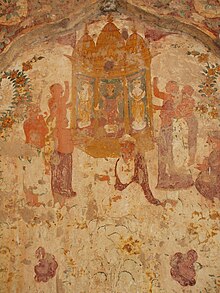
| Part of a series on |
| Sikhism |
|---|
 |
Sikhism prohibits idolatry,[1] in accordance with mainstream Khalsa norms and the teachings of the Sikh Gurus,[2] a position that has been accepted as orthodox.[3][4][5]
Growing Sikh popular discontent with Gurdwara administration and practices during the 1800s,[6][7][5] revivalist movements in the mid-1800s who opposed idol worship like the Nirankaris[7] and the Namdharis[8] (who however have followed a living guru since its inception), and the encroachment of Brahmanical customs in the Golden Temple during that period,[5][2][9] led to the establishment of the Singh Sabha Movement in 1873, in which the Tat Khalsa faction, dominant since the early 1880s, pushed to renew and standardize the practice of Sikhism. After a period of political advancement, the Khalsa faction re-established direct control over Gurdwara management[10] over the Udasi and Hindu[9] mahants, who institutionalized idol worship[5] and would eventually identify with the Sanatan Sikhs, who identified with the Brahmanical social structure[11] and considered idol worship as not harmful.[3] The mahants had gained control of Gurdwaras after heavy Mughal persecution forced the Khalsa to relinquish control of the Gurdwaras and vacate the Punjab plains in the 1700s;[12][13] they were most prominent in the 1800s.[11]
In 1905, after re-establishing institutional control, the Khalsa managed to have removed the idols installed during the preceding period, as well as ending mahant administration and the practice of other non-Sikh, Brahmanical rituals in the process,[6][5] considering them "Hindu accretions" and "Brahmanical stranglehold,"[14] amidst a major controversy within the Sikh community of that era.[3][15][16] The prohibition, state Fenech and McLeod, has also served a means to assert Sikhism differs from Hinduism.[17]
- ^ D.G. Singh (2002), Idolatry is impermissible in Sikhism, Sikh Review, Volume 50, Issue 5, pages 35-37
- ^ a b TN Madan (1994). Martin Marty and R Scott Appleby (ed.). Fundamentalisms Observed. University of Chicago Press. pp. 604–610. ISBN 978-0-226-50878-8. “Both institutions [SGPC and Akali Dal] were envisaged as instruments of the Sikh community for the furtherance of a purified way of religious and social life, without idolatrous priests and in repudiation of ritualism and caste distinctions. Such indeed had been the fundamental teaching of the Gurus.”
- ^ a b c W. H. McLeod (2009). The A to Z of Sikhism. Scarecrow. p. 97. ISBN 978-0-8108-6344-6.
- ^ Louis E. Fenech; W. H. McLeod (2014). Historical Dictionary of Sikhism. Rowman & Littlefield. p. 158. ISBN 978-1-4422-3601-1.
- ^ a b c d e Cite error: The named reference
ks542was invoked but never defined (see the help page). - ^ a b Cite error: The named reference
harnikwas invoked but never defined (see the help page). - ^ a b Cite error: The named reference
mandair78was invoked but never defined (see the help page). - ^ Cite error: The named reference
agnihotrawas invoked but never defined (see the help page). - ^ a b TN Madan (1994). Martin Marty and R Scott Appleby (ed.). Fundamentalisms Observed. University of Chicago Press. pp. 604–610. ISBN 978-0-226-50878-8. “The government had handled the Sikhs with caution, combining patronage with control. Pro-British groups and important individuals were the recipients of this patronage. In return, they were expected to help in keeping hostile elements under control. This was perhaps best exemplified by the fact that the government never allowed the management of the Golden Temple to go completely out of its hands. It thus stood behind the mahants, who were almost invariably unbaptized Sikhs (though claiming affiliation with the Udasi sect founded by one of the sons of the first guru) or plain Hindus. They kept alive idolatry and a great deal of Brahmanical ritual in the temples and were considered venal… The managers of the Golden Temple were particularly disliked, not only for their Hindu origin but also for their loyalty to the British.”
- ^ Pashaura Singh; Louis E. Fenech (2014). The Oxford Handbook of Sikh Studies. Oxford University Press. pp. 28–29, 73–76. ISBN 978-0-19-969930-8.
- ^ a b Mandair, Arvind-Pal Singh (2013). Sikhism: A Guide for the Perplexed (illustrated ed.). London, England: A&C Black. p. 83. ISBN 9781441102317. Retrieved 1 May 2019.
- ^ Arvind-Pal Singh Mandair (2013). Sikhism: A Guide for the Perplexed. Bloomsburg Academic. pp. 83–85. ISBN 978-1-4411-0231-7.
- ^ Cite error: The named reference
hariwas invoked but never defined (see the help page). - ^ Stanley J. Tambiah (1997). Leveling Crowds: Ethnonationalist Conflicts and Collective Violence in South Asia. University of California Press. pp. 154–156. ISBN 978-0-520-91819-1.
- ^ Cite error: The named reference
Khushwant Singh 2006 160was invoked but never defined (see the help page). - ^ Cite error: The named reference
oberoi322was invoked but never defined (see the help page). - ^ Louis E. Fenech; W. H. McLeod (2014). Historical Dictionary of Sikhism. Rowman & Littlefield. p. 158. ISBN 978-1-4422-3601-1.
© MMXXIII Rich X Search. We shall prevail. All rights reserved. Rich X Search
